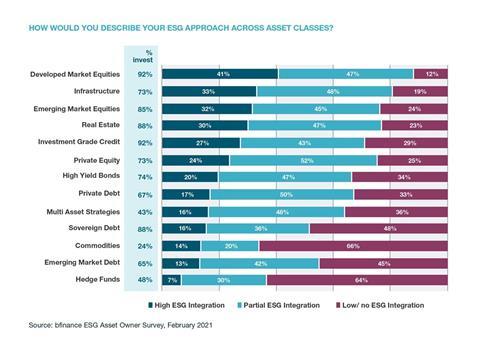
|
|
The hedge fund industry is lagging its peers when it comes to integrating ESG investment factors, according to a survey conducted by specialist consultancy bfinance.
bfinance found that these figures are low relative to other asset classes, and even lower considering that 45% envisage that ESG adoption will be associated with some degree of relative outperformance among hedge funds over the next three years.
That expectation of relative outperformance rises significantly over the longer term, bfinance said. Over the next 20 years, 64% of asset owners expect that ESG integration will be positively associated with hedge fund outperformance, compared to 88% in equities, 85% in private equity and real assets (real estate, infrastructure) and 80% in bonds.
What that ESG integration looks like, however, will vary significantly across different hedge fund strategies, some of which may remain largely untouched by sustainable investment considerations, bfinance said.
But the consultancy found that many hedge funds are still reluctant to make ESG integral to their investment processes. “The additional monitoring and reporting requirements are not yet typical of most hedge funds, nor do many have the capability for active engagement with portfolio companies to drive change,” it added.
Hedge funds may also reject the applicability of ESG considerations to the investment universe or strategy, such as short-term trading. Some argue that ‘ESG trades’ are overly crowded or are unwilling to accept a reduced investment universe.
bfinance said the answer lies in the nature of the strategy. The survey has shown a high-level split between so-called micro assets – individual equity or credit names – being more ESG-relevant than macro assets – index futures, forwards, ETFs and options.

This division typically carries through to specific strategy labels as well: equity and credit long-short strategies, for example, are highly adaptable to ESG screening, whereas CTA and discretionary global macro strategies present more of a challenge.
However, even some of the largest practitioners of systematic trading and macro strategies have begun to adapt their approaches to reflect increased awareness of ESG, bfinance said.
London-based Aspect Capital, which began integrating ESG factors in November 2020, uses company-specific ESG data as a source of “useful information on the future outperformance” and implements an overlay that creates a portfolio-level tilt towards “good” ESG assets.
“It’s no longer enough to say ‘ESG isn’t relevant to our strategy,’” said John Springett, Aspect Capital’s director of investor relations and marketing.
The rise of ‘green’ securities
The report also found that hedge fund managers are starting to use new products, services, securities and data to advance ESG integration.
In fixed income, the green bonds market is expanding rapidly as governments seek to mitigate the economic shock of the COVID-19 pandemic and embed sustainable development goals.
Last September, Germany issued its first-ever green bonds, with a 10-year maturity, in a heavily oversubscribed floatation that raised €6.5bn. Germany now plans to create a green sovereign bond curve ranging from 2 to 30 years.
France and Italy have also ramped up their issuance of green bonds, and in March, the UK announced plans to issue two tranches of “green gilts” worth a total of £15bn this year.
By far the largest issuance of green bonds will come from the EU itself, however, with the inauguration of the €750bn Next Generation EU (NGEU) programme, which expects to launch its inaugural bond in June 2021, after which it will remain a regular issuer until 2026.
With a planned total issuance of €240bn in green bonds over the next five years, NGEU will soon become Europe’s largest non-sovereign issuer in the public sector.
Chris Stevens, director – diversifying strategies at bfinance, said: “Hedge fund firms may be coming late to the revolution, but their tardiness does confer a singular advantage. Their managers can look to see where mistakes have already been made by some mainstream asset management houses and avoid those missteps.”
He added: “When hedge fund firms, as an industry, decide to embrace ESG integration and move to meet investor demand, we expect the transition to happen swiftly.”